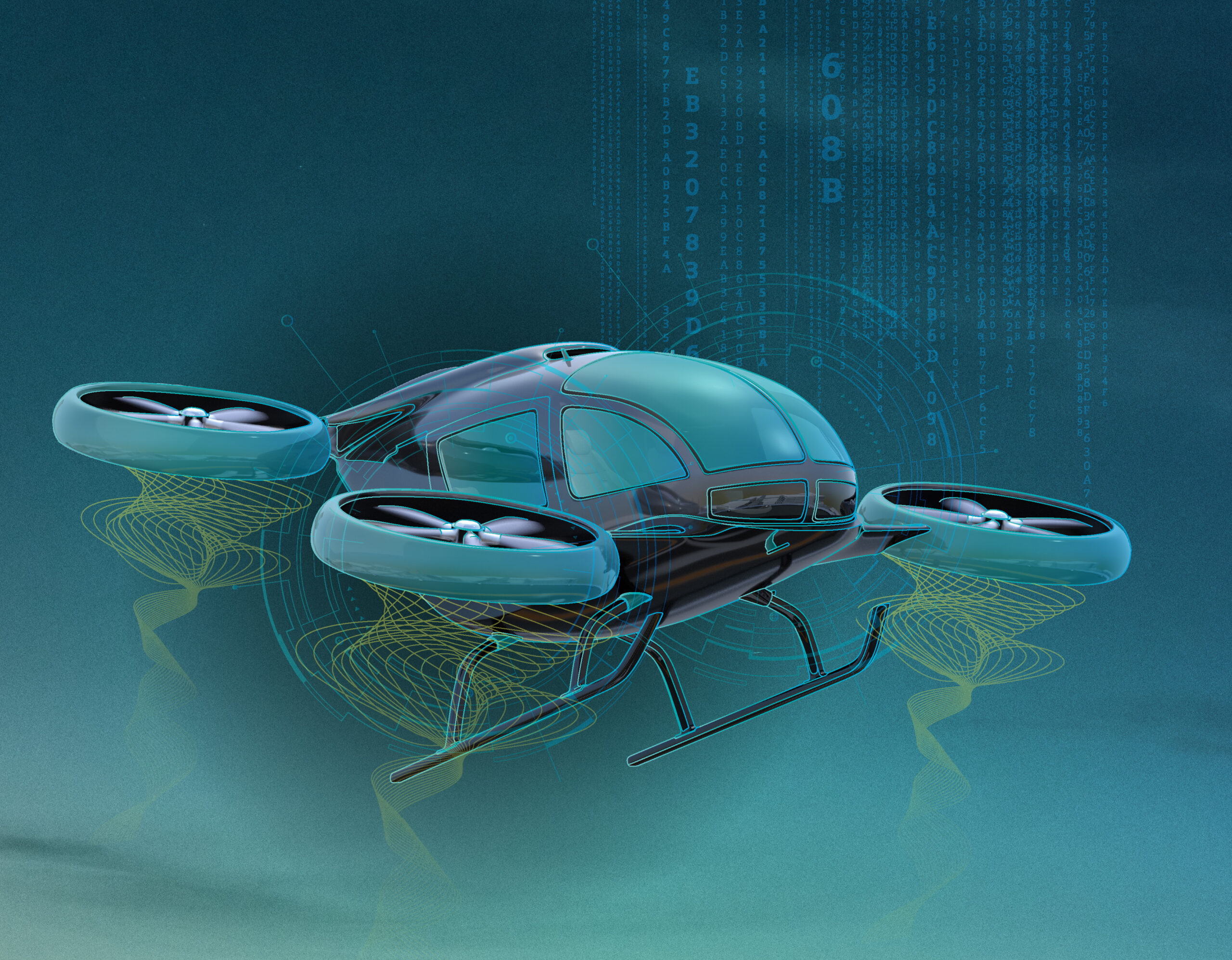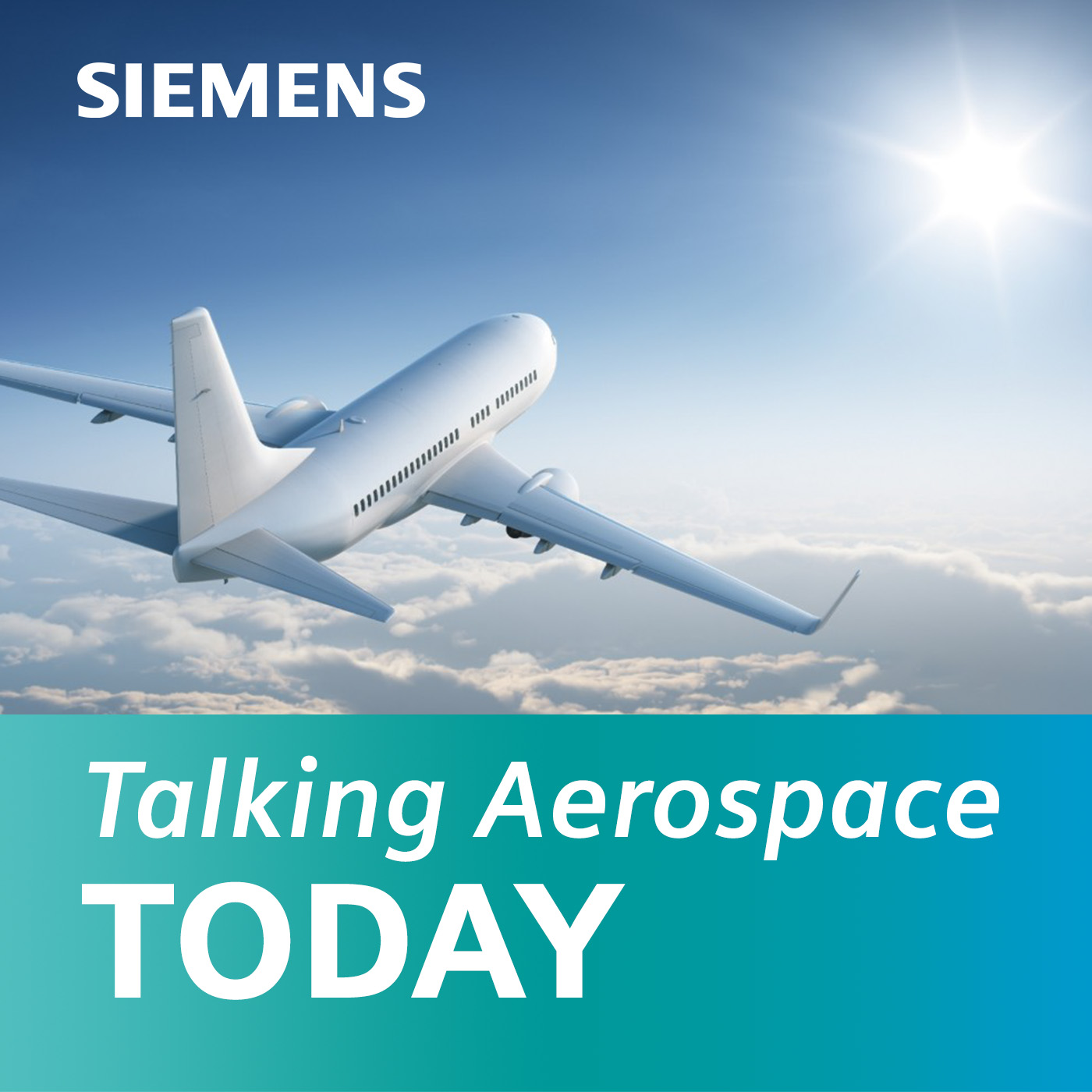“Innovation” podcast series (Ep. #1): Up, Up and Away – eVTOL Vehicles in the Age of Digital Transformation

Wow… We are experiencing unprecedented innovation in the A&D industry these days. There’s just so much excitement around space missions, supersonic air travel and urban air mobility to name just a few of the more promising areas. Of course, the digital transformation has a lot to do with the success of these emerging technologies.
Innovation is everywhere. We’re seeing breakthroughs in propulsion, composites and additive manufacturing. Augmented and virtual reality are now part of the factory floor. Electrification is a huge deal. The list goes on and on.
The one area where innovation is truly taking off is electric vertical take-off and landing (eVTOL) aircraft. This entire innovation podcast series will focus on eVTOLs from a number of different design domains and disciplines. This first episode touches on the first wave of aerospace innovation back in the 1920s and then jumps to the innovation we’re seeing today around urban air mobility and eVTOL development.
Listen to episode #1 now.
Listen to all episodes in our eVTOL innovation series here:
Episode #2 – “Aerodynamic design through digitalization“
Episode #3 – “Power density and thermal management”
Episode #4 – “Structural design using composites and additive manufacturing”
Episode #5 – “Electrical system design and compliance”
Welcome to Talking Aerospace Today – a podcast for the Aerospace & Defense industry. A place that brings the promise of tomorrow’s technology to the ears of our listeners today.
The A&D industry is experiencing unprecedented innovation these days. There’s so much talk around space missions, supersonic travel and urban air mobility such as eVTOL aircraft. We’re seeing breakthroughs in propulsion and in composites and additive manufacturing. Electrification is huge right now… The list goes on and on.
In this first episode of the five-part series on “Driving Innovation through Digital Transformation,” we’ll take a quick look back at the early days of aerospace – the first wave of innovation. Back to the Wright Brothers. And then we’ll fast forward to the current landscape and the technologies that are fueling innovation today. We’ll be taking a very close look at how all this innovation is giving birth to a whole new way of flying – urban air mobility.
I am your host, Scott Salzwedel, and I am joined by Dale Tutt, the go-to guy for all things aerospace & defense. Dale is the Vice President of Aerospace & Defense at Siemens Digital Industries Software. He has over 30 years of experience in engineering design, development, and program leadership within the aerospace industry. Dale specializes in building highly effective, cross-functional teams to achieve complex operations when building today’s aircraft. Before Siemens, he worked at The Spaceship Company, Textron Aviation, and Bombardier Aerospace.
Join me for what promises to be an eye-opening series. Tune in to learn how the digital transformation in aerospace is fueling unprecedented growth and innovations.
Yes, these are exciting times!
In this episode, you’ll learn:
- The early days of modern aviation. (02:17)
- The current wave of urban air mobility and its impact on the future. (04:06)
- The challenges faced by eVTOL startups. (06:36)
- How the Siemens Xcelerator portfolio helps eVTOL companies with their digital transformation. (08:34)
- How Siemens helps customers to go faster and to be more productive and innovative. (10:28)
Connect with Dale:
For more information, please visit the Siemens Aerospace & Defense website.
Podcast Transcript:
Scott Salzwedel: Hello, this is Talking Aerospace Today – a podcast for the Aerospace & Defense industry, a place that brings the promise of tomorrow’s technology to the ears of our listeners today. And I’m your host, Scott Salzwedel. Welcome to episode one of our new five-part series: “Driving Innovation through Digital Transformation.” We are experiencing unprecedented innovation in the A&D industry these days. There’s just so much to talk about from space missions, supersonic travel, urban air mobility, such as the eVTOL aircraft. We’re seeing breakthroughs in composites and additive manufacturing. Augmented and virtual reality are now part of the factory floor. Electrification is a huge deal. The list just goes on and on.
Today, in our first podcast, we’ll take a quick look back at the early days of aerospace – the first wave of innovation. And then we’ll fast forward to the present to discuss our current wave of innovation. We’ll be taking a closer look at some of the technologies fueling innovation today. We’re talking about the digital transformation here, folks. More on that later. I’m pleased to introduce Dale Tutt, Vice President of Aerospace & Defense at Siemens Digital Industries Software. Dale is the go-to guy for all things Aerospace & Defense. Welcome, Dale! Thanks for stopping by today.
Dale Tutt: Hey, thanks, Scott! I’m more than happy to be here today and I’m really looking forward to our discussion.
Scott: Great! So, a little bit more about Dale. Dale has over 30 years of experience in engineering design, development and program leadership within the aerospace industry. He specializes in building highly effective, cross-functional teams to achieve complex operations when building today’s aircraft. Before Siemens, Dale worked at The Spaceship Company which is now part of Virgin Galactic, Textron Aviation and Bombardier Aerospace. Alright Dale, let’s dive into our first episode. It only makes sense that we go back to the early days when modern aerospace was first invented.
Dale: Definitely, Scott. We’ve had aviation for more than 100 years and the first wave of aviation innovation really started with Samuel Pierpont Langley and the Wright brothers. Langley is often considered the father of aviation. He introduced the steam-powered unmanned aerodrome roughly in 1896. He’s also the inventor of the ailerons and he brought that technology. Prior to that, the Wright brothers had used wing warping. But aviation innovation itself as we know it, really started with the Wright brothers. Orville Wright once said, “If we worked on the assumption that what is accepted as true, really is true, then there would be little hope for advance.” This is really at the heart of innovation. Working out of their bicycle shop, they first flew in 1903. It’s hard to believe it’s been 117 years since that first flight. And when I look back in history, and I look at what I think is one of the heydays of aviation, the 1920s was a period of significant innovation. There were aircraft companies starting everywhere, little startups everywhere, and there were competitions to help foster innovation within aviation. In 1925, three men started Travel Air Manufacturing Company in Wichita, Kansas; Clyde Cessna, Walter Beech, and Lloyd Stearman. The company itself only lasted a few years, but these three giants in aviation went on to found their own airplane companies after that: Cessna Aircraft, Beechcraft, and Stearman, which eventually merged with Boeing.
Scott: Exactly… And today, in our current wave of innovation, you have hundreds of companies working in this new era of what’s called Urban Air Mobility. Just like in the 1920s there are dozens of companies trying to be first. Dale, how will this new wave of urban air mobility change the future?
Dale: If I think about it, there’s hundreds of companies. And when you think about all of the innovation out there, it really reminds me, as I said earlier, about the 1920s. And all of these companies, whether it’s supersonic business jets, supersonic airliners, small startup companies working on these projects, you have companies working on electric propulsion for regional aircraft and for airliners. Airbus recently announced the development of hydrogen propulsion systems for their aircraft. We’re seeing this emergence of electric and hydrogen propulsion. The 2030s might be the decade of electric aircraft and then the 2040s might be the decade of hydrogen-powered aircraft. You’re also seeing all this innovation in these electric vertical takeoff and lift aircraft, or as we like to say, urban air taxis. There’s hundreds of companies out there working and they’re innovating, and they’re bringing fresh ideas to the marketplace. Big and small companies, all involved with it, just like back in the 1920s. Some of it generates excitement because people can see themselves and how it can change their life. You see companies like Uber working on air taxis, and you see all these companies working on these personal air vehicles. So, think about it, you can take off from your home, you can fly to where you work, you can recharge for the day, and then you can fly home again and this is all being done in an autonomous air taxi so that you’re able to relax on your short flight to work instead of your hour-long commute on the freeway. And so, these companies, there’s a huge business case to develop air taxis. You go to places like Los Angeles or Dallas or big cities all over the world, where they’re looking to unlock the gridlock, and replace it with the freedom and flexibility of air taxis, saving people time and money. All of a sudden now, instead of hour-long commutes on the road, you’re now talking minute-long commutes – you know, tens of minutes-long commutes. And so, there’s a lot of interest from a lot of people. It will really change the face of our mobility all around the world.
Scott: Let’s talk present day to near future. It seems electric vertical takeoff – the eVTOL as you’ve already referred to – these aircraft are very hot right now. What are some of the challenges eVTOL startups are facing?
Dale: Yeah, so, these are much different design vehicles than what we have today. And so, as they’re designing these things, there’s challenges around their aerodynamics, the design of their rotor systems, the structures to make very lightweight structures. There’s thermal challenges because they have all these electrical systems and the design of your batteries and how you’re going to have enough power for these air taxis. There’s complex systems, there’s lots of software, and there’s electrical systems. And, you know, even though we’re talking about this in the context of urban air mobility, there’s really a lot of similarity to a lot of our other aircraft challenges out there, as well, that from a technical standpoint, you know, you’re seeing more electrical aircraft, you’re seeing more software, you’re seeing new demand for lightweight structures and more efficient aerodynamics. And so, some of the things that we’ll be talking about with urban air mobility apply to everything that we do today. And similarly, these companies face the same trends and complexities that the Aerospace & Defense industry, as a whole, faces. These companies that are working on these eVTOL aircraft, they face the same pressures to reduce costs and schedule. They need to get to market faster, they need to be good stewards of their investors’ money, and they need to be able to manage their programs effectively and obtain the technical performance that they need. We’re seeing this, you know, continual increase program complexity and integration, especially with all the electrical systems and the software. And then, in general, we’re just seeing increased electrification as companies look at these new electrical propulsion systems as well as look at ways to improve the overall reliability and maintainability of their products.
Scott: Well, how do these eVTOL companies survive and even thrive in the face of so much complexity today? I would imagine cost and budget are a huge concern. And we talk about Siemens Xcelerator as a means to help companies with their digital transformation. Does that apply here as well?
Dale: Absolutely! I think, you know, the Xcelerator portfolio really brings together all the services, the software, the solutions, the cloud applications – it brings all of our solutions together in a single portfolio. And it’s really about embracing digital transformation for these companies. It scales to any size of the company, or any size of program to really enable those programs, those companies to have, you know, full digital transformation. And then, as they grow, as the company grows, as their program grows, it scales up with them so you can continue building on the foundation of digital transformation that you started. What’s this based on? It’s based on having the comprehensive digital twin and digital threads – this very rich, robust understanding of how your product and your production processes work. And once you have that understanding, you’re now able to reduce the risk of your designs or your production process as you go forward. We also bring in personalized and adaptable solutions using rapid application development. So, for competitive advantage, you need to be able to develop and personalize these solutions faster than the next guy. We bring that in as part of our Xcelerator solution. And then, finally, you have to be able to operate in this flexible and open ecosystem to really be able to incorporate the latest technology. The technology is happening so fast, the innovations are happening so fast that to gain true competitive advantage, you have to be able to incorporate it easily in a very flexible and open solution. So, when we combine all of these approaches, this really helps speed innovation and it’s really a key element of your digital engineering strategy, as you seek to go faster.
Scott: And when we talk about Siemens digital engineering strategy, I think of the digital thread of program execution excellence and innovation.
Dale: When we talk about the Xcelerator portfolio in the context of aerospace and defense companies, it’s really about how do we help them with program execution excellence? How do we help them go faster? So, when we think of program execution excellence, it’s about developing and certifying products faster with less risk. It’s about accelerating your production ramp-ups. It’s about improving your product support and being able to provide superior customer support to your customers and reduce their operational costs. And the value to the customers – to our customers – is that they get to market faster with higher performing products. We bring this out in a number of what we call A&D industry digital thread solutions – things like integrated program planning and execution (IPP&E), which helps support companies with their program management, or our product engineering solutions or our manufacturing solutions. And so, we’ve organized these solutions in the context of helping companies go faster, be more productive, and be more innovative.
Scott: You know, Dale, it feels like we’re just getting started – and I’m afraid we’ve run out of time. But listeners, there are four more episodes planned. So really, we’re just getting started. Dale, can you share with our listeners the upcoming topics of our innovation series?
Dale: Yeah, absolutely, Scott. Innovation is really something I’m passionate about. I can’t wait to jump into these upcoming episodes. We’re going to have some good discussions. And we’ve brought several experts in to help with these discussions. So, in the next episode, we’re going to talk about aerodynamics design with Durrell Rittenberg. And he’s going to bring some of his experience and some of his background into how companies are solving the riddle of the aerodynamics design for their rotor development, for the actual just aerodynamics to get the performance that they need of the aircraft itself. And then, in episode three, we’re going to talk about power density and thermal management with Thierry Olbrechts. And he’s going to talk about some of the challenges that, as you have these electrical systems on the airplane, you have these huge needs for electrical power. How do you manage the thermal heating on the systems as well as the overall power density of your batteries? After that, a subject that I always enjoy talking about is we’re going to talk about structural design using composites and additive manufacturing and that’ll be episode four. And we brought John O’Connor, one of our experts in this area of our composites and manufacturing solutions. We’ll talk about how we make aircraft structures lighter, how we make them easier to build and how we make them more efficient. And then, finally, in episode five, we’re going to talk about the EE and the eVTOL – the electrical system design. We’ll bring in Tony Nicoli, and he’ll talk about how companies are solving the challenges of their complex electrical systems design as they go through their design development certification processes. And so, we’re really pleased to be talking about all these subjects, and we’re pleased to have these experts joining us on these episodes as we go forward.
Scott: Yeah, it sounds great! I’m really looking forward to it. So, I think what we’ve learned here today, in this short period of time, is that Siemens Aerospace and Defense is ahead of the curve when it comes to innovation. It just surprises me just what we’re doing nowadays. You know, we’re bringing the technology of tomorrow to our customers today in a number of very real and proven ways. So, thank you for visiting, Dale. My sincere thanks to you!
Dale: Hey, no problem, Scott! And thanks for having me today. And I’m really looking forward to the upcoming series of podcasts.
Scott: And, of course, I’d like to extend my deepest thanks to our listeners. I’m glad you tuned into this podcast. Thank you, listeners!
At the top of the show I mentioned this is a five-part series. If you enjoyed this episode and you don’t want to miss an upcoming episode, please subscribe to Talking Aerospace Today on Apple iTunes, Spotify, or wherever you go to get your favorite podcast – that way, you won’t miss a single episode. You can also check out the links in this podcast’s description.
My name is Scott Salzwedel, and this is Siemens Talking Aerospace Today. I hope you’ll join us again for our next podcast. Until then, bye for now.

Dale Tutt – Vice President of Industry Strategy at Siemens Digital Industries Software
Dale Tutt is Vice President of Industry Strategy at Siemens Digital Industries Software. Dale leads a team of experts to develop and execute industry-specific product and marketing strategies in collaboration with the global product, sales, and business development teams. With over 5 years of experience in this role combined with extensive experience in the aerospace and defense industry, Dale has a deep understanding of the challenges and opportunities facing companies as they embark on their digital transformation journeys.

Scott Salzwedel – Host
Scott Salzwedel is senior technical writer and corporate communications writer involved in the Siemens Aerospace & Defense Industry and Siemens Capital. In addition to writer/host of Talking Aerospace Today, Scott is the writer of white papers, articles, blogs, videos and websites at Siemens.

Talking Aerospace Today Podcast
The A&D Industry is at a serious inflection point. Transformation to the digital enterprise has opened up a new era in innovation and technological breakthroughs. However, complexity and compliance continue to hamper the best of efforts.
Join us as we explore how Siemens is turning complexity into a competitive advantage for many of our customers – today and well into tomorrow.


